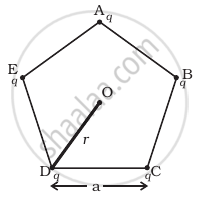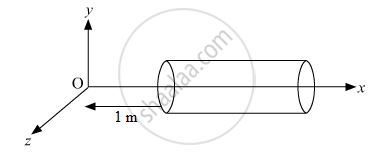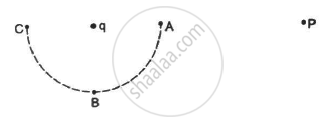Advertisements
Advertisements
प्रश्न
Five charges, q each are placed at the corners of a regular pentagon of side ‘a’ (Figure).

(a) (i) What will be the electric field at O, the centre of the pentagon?
(ii) What will be the electric field at O if the charge from one of the corners (say A) is removed?
(iii) What will be the electric field at O if the charge q at A is replaced by –q?
(b) How would your answer to (a) be affected if pentagon is replaced by n-sided regular polygon with charge q at each of its corners?
उत्तर
(a) (i) The point O, the centre of the pentagon is equidistant from all the charges at the end point of pentagon. Thus, due to symmetry, the electric field due to all the charges is cancelled out. As a result, electric field at O is zero.
(ii) We can write that the vector sum of electric field due to charge A and electric field due to the other four charges at the centre of cube should be zero or, `vecE_A + vecE_("four charges") = 0`
Hence `vecE_("four charges") = - vecE_A` or ⇒ `|vecE_("four charges")| = |vecE_A|`
When charge q is removed from A, net electric field at the centre due to remaining charges `|vecE_("four charge")| = |vecE_A| = 1/(4 piε_0) q/r^2` along OA.
(iii) If charge q at A is replaced by –q, then electric field due to this negative charge
`vecE_(-q) = 1/(4 piε_0) q/r^2` along OA.
HEnce net electric field at the centre
`vecE_("net") = vecE_(-q) + vecE_("four charges") = 1/(4 pi ε_0) q/r^2 + 1/(4 pi ε_0) q/r^2`
`vecE_("net") = 1/(4 pi ε_0) (2q)/r^2` along OA.
(b) If pentagon is replaced by n-sided regular polygon with charge q at each of its comers. Here again, charges are symmetrical about the centre. The net electric field at O would continue to be zero, it doesn’t depend on the number of sides or the number of charges.
APPEARS IN
संबंधित प्रश्न
The figure shows tracks of three charged particles in a uniform electrostatic field. Give the signs of the three charges. Which particle has the highest charge to mass ratio?

Show that if we connect the smaller and the outer sphere by a wire, the charge q on the former will always flow to the latter, independent of how large the charge Q is.
A hollow cylindrical box of length 1 m and area of cross-section 25 cm2 is placed in a three dimensional coordinate system as shown in the figure. The electric field in the region is given by `vecE = 50xhati` where E is NC−1 and x is in metres. Find
(i) Net flux through the cylinder.
(ii) Charge enclosed by the cylinder.

Consider the situation in the figure. The work done in taking a point charge from P to Ais WA, from P to B is WB and from P to C is WC.

The electric field in a region is directed outward and is proportional to the distance rfrom the origin. Taking the electric potential at the origin to be zero,
A 10-cm long rod carries a charge of +50 μC distributed uniformly along its length. Find the magnitude of the electric field at a point 10 cm from both ends of the rod.
Consider a uniformly charged ring of radius R. Find the point on the axis where the electric field is maximum.
Find the magnitude of the electric field at the point P in the configuration shown in the figure for d >> a.
Assume that each atom in a copper wire contributes one free electron. Estimate the number of free electrons in a copper wire of mass 6.4 g (take the atomic weight of copper to be 64 g mol−1).
Which of the following methods can be used to charge a metal sphere positively without touching it? Select the most appropriate.
